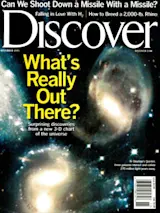Quantum Leaps of Faith Perhaps physicists disagree with David Deutsch's interpretation of quantum theory ["Quantum Shmantum," September] not because it is too strange but because it is too simplistic. I can accept that every particle of my body exists in parallel universes. I cannot accept that these particles are necessarily organized into human beings who have any resemblance to me. In fact, I see no reason to assume that these particles are organized into human beings at all. All of the evidence cited by Deutsch is applicable only to experimental conditions and involves only atomic or subatomic particles. Scientists can teleport atoms, but can they teleport people? Similarly, even if Deutsch could build a supercomputer that utilizes matter from other universes, this still wouldn't prove parallel David Deutsches exist in other universes. All it would prove is that there are parallel universes.
Rob DobsonOverland Park, Kansas
I don't see how the existence of many universes containing the same people making different choices could be possible. Each of our individual choices would shape the future in ways that would cause these parallel universes to diverge. The only way that many universes containing the same set of humans could coexist is if one of the universes were the primary one, upon which the occurrences in all other universes were contingent. However, if this were so, the humans in the other universes would not have free will, because their choices would have to agree with those made in the "parent" universe.
Colleen VojakChampaign, Illinois
Deutsch's theory of alternate universes doesn't demonstrate the certitude of free will. In fact, it does the opposite because it turns quantum physics' "something might happen" into "everything must happen." Therefore, the path you find yourself on has less to do with choice than with the way a particular electron is spinning.
Robert CrawfordSan Antonio, Texas
Having been a subscriber for a while now, I immediately saw a relationship between Deutsch's multiverse and the subject of another Tim Folger piece ["From Here to Eternity," December 2000]: the concept of time--or rather the lack thereof--as espoused by Julian Barbour. I am wondering if the two theories are actually related in any way. After all, if the thought of a multiverse isn't strange enough, the idea of infinite alternate universes existing for all eternity is sure to challenge one's mental capacities.
Jason MummHighlands Ranch, Colorado
Tim Folger responds: The two theories are indeed related, as Deutsch and Barbour acknowledge. Using very different arguments, the two physicists arrive at strikingly similar conclusions. Although Barbour is concerned with understanding the nature of time and Deutsch with the nature of quantum mechanics, both conclude that each instant of time constitutes an entire, independent universe and that the strange properties of quantum mechanics describe the universe on the very largest scales imaginable.
Something Fishy "Fear and Evolution" [NeuroQuest, August] includes drawings of reptile, bird, pig, and human embryos with ridged structures identified as "gill pouches." However, the recent book Icons of Evolution cites evidence that discredits the identification of these structures as gill pouches. No informed scientist believes these ridged structures have any relationship to gills, either embryonic or fully developed.
Edward SissonWashington, D.C.
Eric Haseltine responds: All vertebrate embryos possess, at one time or another, what many textbooks describe as "branchial arches" (literally, "gill arches"). Other texts call these "pharyngeal arches," a term that is perhaps more accurate, because parts of these structures develop into gills only in fish and some amphibians. In humans, pharyngeal pouches (a component of the arches) develop into structures like the ear canal and tonsils. Therefore, I agree that the "gill pouches" in both the text and the figure could have been more accurately termed "pharyngeal arches."
Click here for more letters.














